hood open AUDI A8 2013 User Guide
[x] Cancel search | Manufacturer: AUDI, Model Year: 2013, Model line: A8, Model: AUDI A8 2013Pages: 318, PDF Size: 79.34 MB
Page 234 of 318
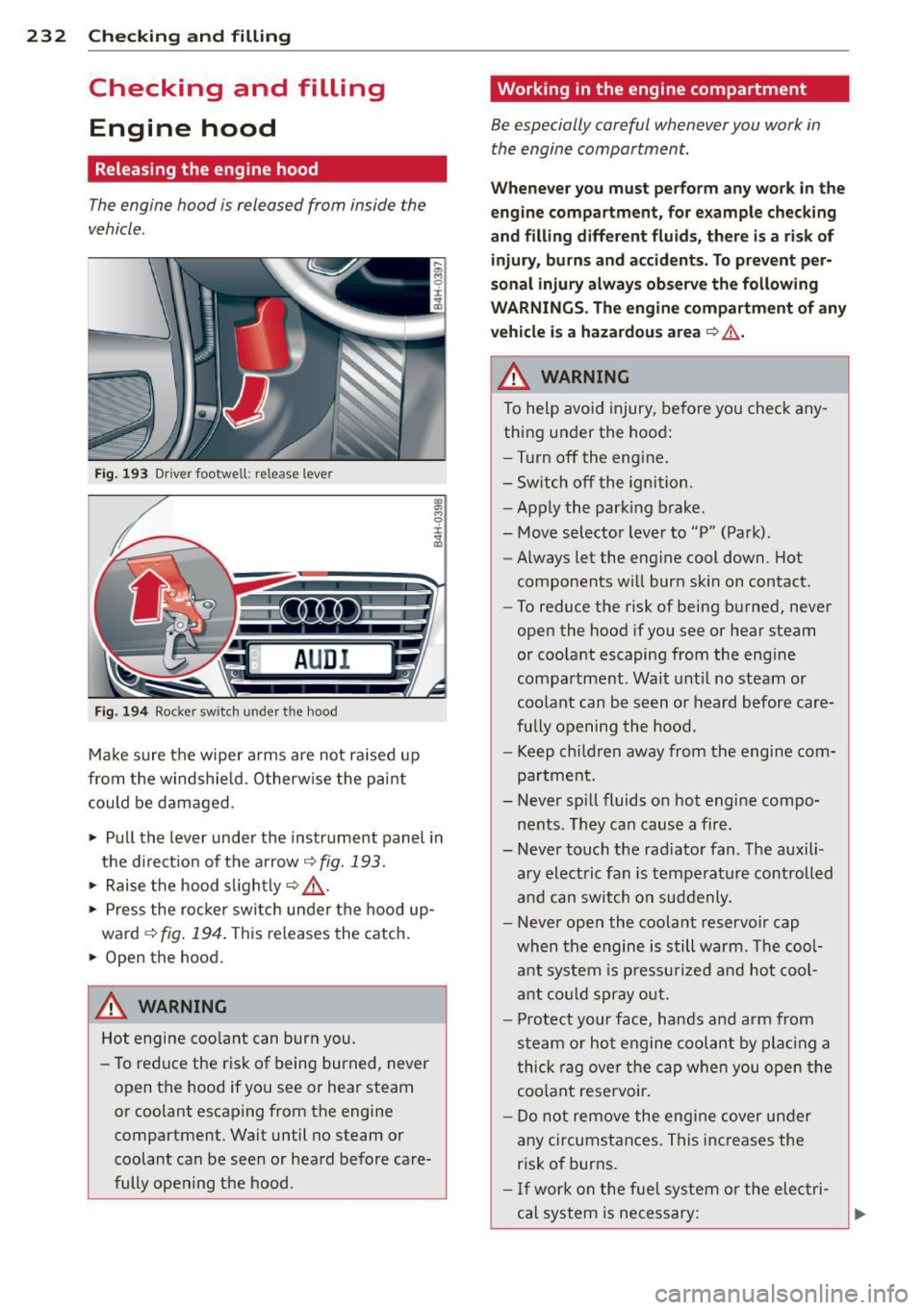
232 Checking and filling
Checking and filling Engine hood
Releasing the engine hood
The engine hood is released from inside the
vehicle .
Fig. 193 Driver foo twell: release lever
AUD I
Fig. 194 Rocker switch un der the hood
Make sure the wiper arms are not raised up
from the windshield. Otherwise the paint
could be damaged .
.,. Pull the lever under the instrument panel in
the direction of the arrow
~ fig. 193.
.,. Raise the hood slightly~,&. .
... Press the rocker switch under the hood up
ward
~ fig. 194. This releases th e catch.
... Open the hood.
&_ WARNING
Hot engine coolant can burn you.
- To reduce the risk of being burned, never
open the hood if you see or hear steam
or coolant escaping from the engine compartment . Wait until no steam or
coolant can be seen or heard before care
fully opening the hood .
' Working in the engine compartment
Be especially careful whenever you work in
the engine compartment.
Whenever you must perform any work in the
engine compartment, for example checking
and filling different fluids, there is a risk of injury, burns and accidents. To prevent per
sonal injury always observe the following
WARNINGS. The engine compartment of any
vehicle is a hazardous area
~ ,&. .
A WARNING
To help avoid injury, before you check any
thing under the hood:
- Turn off the engine.
- Switch off the ignition .
- Apply the parking brake.
- Move selector lever to "P" (Park) .
- Always let the engine cool down. Hot
components will burn skin on contact.
- To reduce the risk of being burned, never
open the hood if you see or hear steam
or coolant escaping from the engine
compartment. Wait until no steam or
coolant can be seen or heard before care
fully opening the hood.
- Keep children away from the engine com
partment.
- Never spill fluids on hot engine compo
nents . They can cause a fire .
- Never touch the radiator fan. The auxili
ary electric fan is temperature controlled
and can switch on suddenly .
- Never open the coolant reservoir cap
when the engine is still warm . The cool
ant system is pressurized and hot cool
ant could spray out.
- Protect your face, hands and arm from
steam or hot engine coolant by placing a
thick rag over the cap when you open the
coolant reservoir.
- Do not remove the engine cover under
any circumstances. This increases the
risk of burns.
- If work on the fuel system or the electri
cal system is necessary:
Page 235 of 318

-Always disconnect the battery.
- Never smoke or work near heaters or open flames. Fluids in the engine com
partment could start a fire.
- Keep an approved fire extinguisher im
mediately available.
- To avoid electrical shock and personal in
jury while the engine is running or being
started, never touch :
- Ignition cables
- Other components of the high voltage
electronic ignition system.
- If you must perform a check or repair
with the engine running:
- First, fully apply the parking brake,
move selector lever to "P" (Park).
- Always use extreme caution to prevent
clothing, jewelry, or long hair from get
ting caught in the radiator fan, V-belts
or other moving parts, or from contact ing hot parts. Tie back hair before
starting, and do not wear clothing that
will hang or droop into the engine.
- Minimize exposure to emission and
chemical ha zards c:::> & .
A WARNING
California Proposition 65 Warning:
- Engine exhaust, some of its constituents,
and certain vehicle components contain
or emit chemicals known to the State of
California to cause cancer and birth de
fects and reproductive harm. In addition ,
certain fluids contained in vehicles and
certain products of component wear con
tain or emit chemicals known to the
State of California to cause cancer and
birth defects or other reproductive harm .
Checking and filling 233
-Battery posts, terminals and related ac
cessories contain lead and lead com
pounds, chemicals known to the State of
California to cause cancer and reproduc
tive harms. Wash hands after handling.
(D Note
When adding fluids, always make sure that
they are poured into the proper container
or filler opening, otherwise serious dam
age to vehicle systems will occur.
(® For the sake of the environment
To detect leaks in time, inspect the vehicle
floor pan from underneath regularly . If
you see spots from oil or other vehicle flu ids, have your vehicle inspected by an au
thorized Audi dealer.
Closing the engine hood
.,. Pull the hood down until the pressure from
the struts is reduced.
"' Let the hood
drop down and latch in place.
Do not try to push it shut; it may fail to en
gage
c:::> ,A .
A WARNING
-
A hood that is not completely latched
could fly up and block your view while driv
ing .
- When you close the engine hood, check it
to make sure the safety catch has proper ly engaged. The hood should be flush
with the surrounding vehicle body parts.
- If you notice while driving that the hood
is not secured properly , stop at once and
close it. •
•
Page 239 of 318
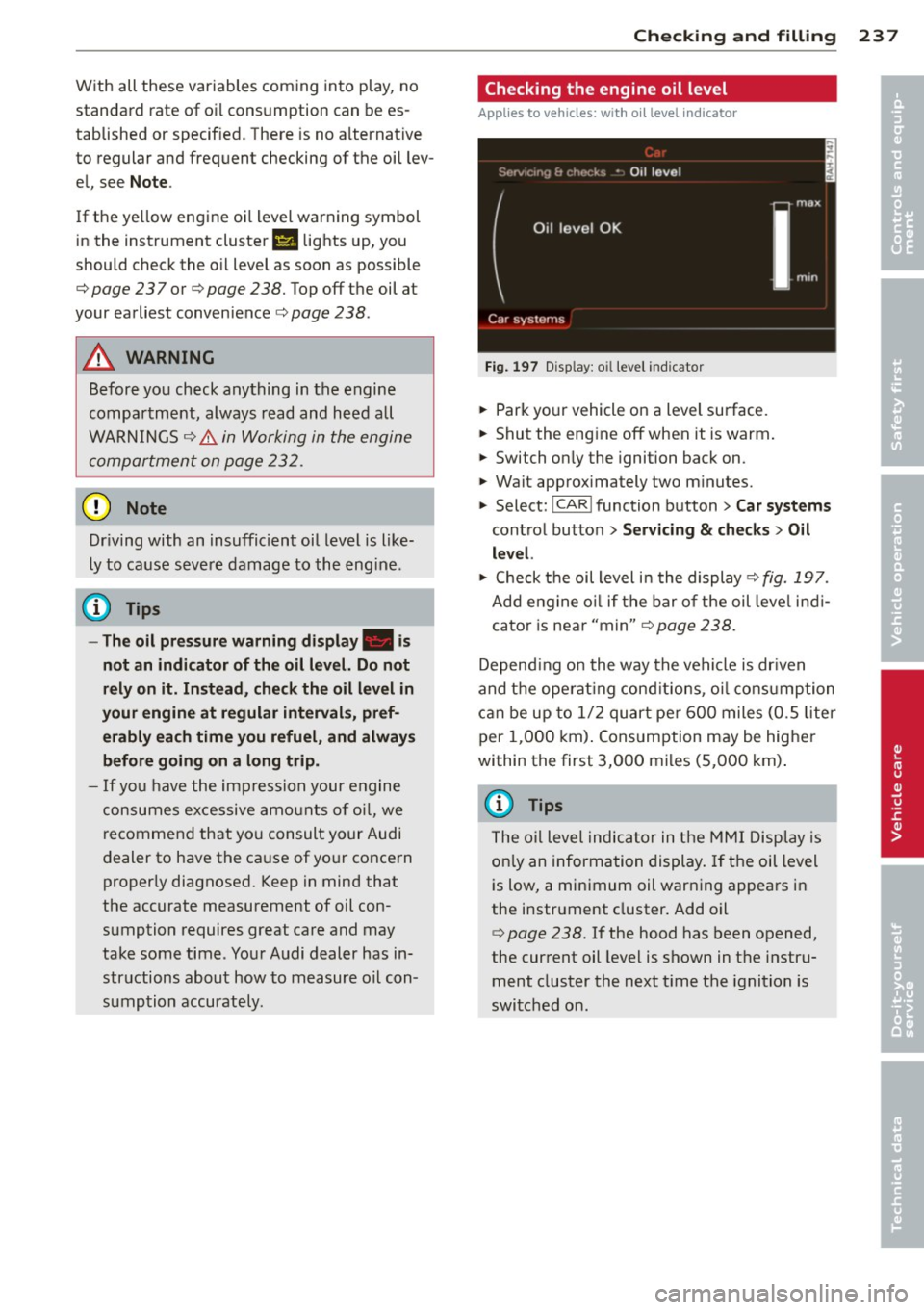
With all these variables coming into play, no
standard rate of oil consumption can be es
tablished or specified . There is no alternative
to regular and freq uent checking of the oi l lev
e l, see
Note .
If the ye llow engine oi l level war ning symbol
in the instrument cluster
II lights up, you
should check the o il level as soon as possible
¢
page 23 7 or ¢ page 238. Top off the oil at
your earliest convenience¢
page 238 .
.&_ WARNING
Before yo u check anything in the engine
compartment, always read and heed all
WARN INGS
¢ &. in Working in the engine
compartment on page 232.
0 Note
Dr iving with an insufficient oil level is like
ly to ca use seve re damage to the eng ine.
{1) Tips
- The oil pressu re warning display. i s
not an indicator of the oi l level. Do not
rely on it. Instead , check th e oil level in
your engine at regular interval s, pref
erably each time you refuel, and always before going on a long trip .
-If yo u have the impres sion your engine
consumes excessive amo unts o f oil, we
r ecommend that yo u consult your Audi
dealer to have the ca use of yo ur conce rn
proper ly diagnosed . Keep in mind that
the accurate measurement of oil con
sumption requires great care and may
take some time. You r Audi dealer has in
str uctions about how to measure o il con
sumption accurately.
Checkin g and fillin g 237
Checking the engine oil level
Applies to vehicles : wit h oil level indicator
Fi g. 1 97 Disp lay: o il leve l indicator
.,. Park yo ur vehicle on a level surface.
.,. Shut the eng ine off when it is warm .
.,. Switch on ly the ignition back on .
.,. Wait approx imately two m inutes.
.,. Select:
I CAR ! function button > Car systems
contro l butto n > Servicing & checks > Oil
level.
.,. Check t he oil level i n the display ¢ fig. 197.
Add eng ine o il if t he bar o f the oil leve l ind i
cator is near "min"¢
page 238.
Depend ing on the way the vehicle is dr iven
and t he ope rat ing cond it ions, oi l cons umption
c a n be up to 1/ 2 quart pe r 60 0 miles (0.S liter
per 1,000 km) . Cons umption may be higher
within the first 3,000 m iles (S,000 km) .
(D Tips
The o il leve l indic ato r in the MMI Disp lay is
on ly an informa tion display.
If t h e oil level
i s low, a minimum oil warn ing appears in
the instrument cluster. Add oil
¢
page 238. If the hood has been opened,
the current oil level is shown in t he instr u
ment cluster the next t ime the ignition is
swi tched on.
•
•
Page 248 of 318
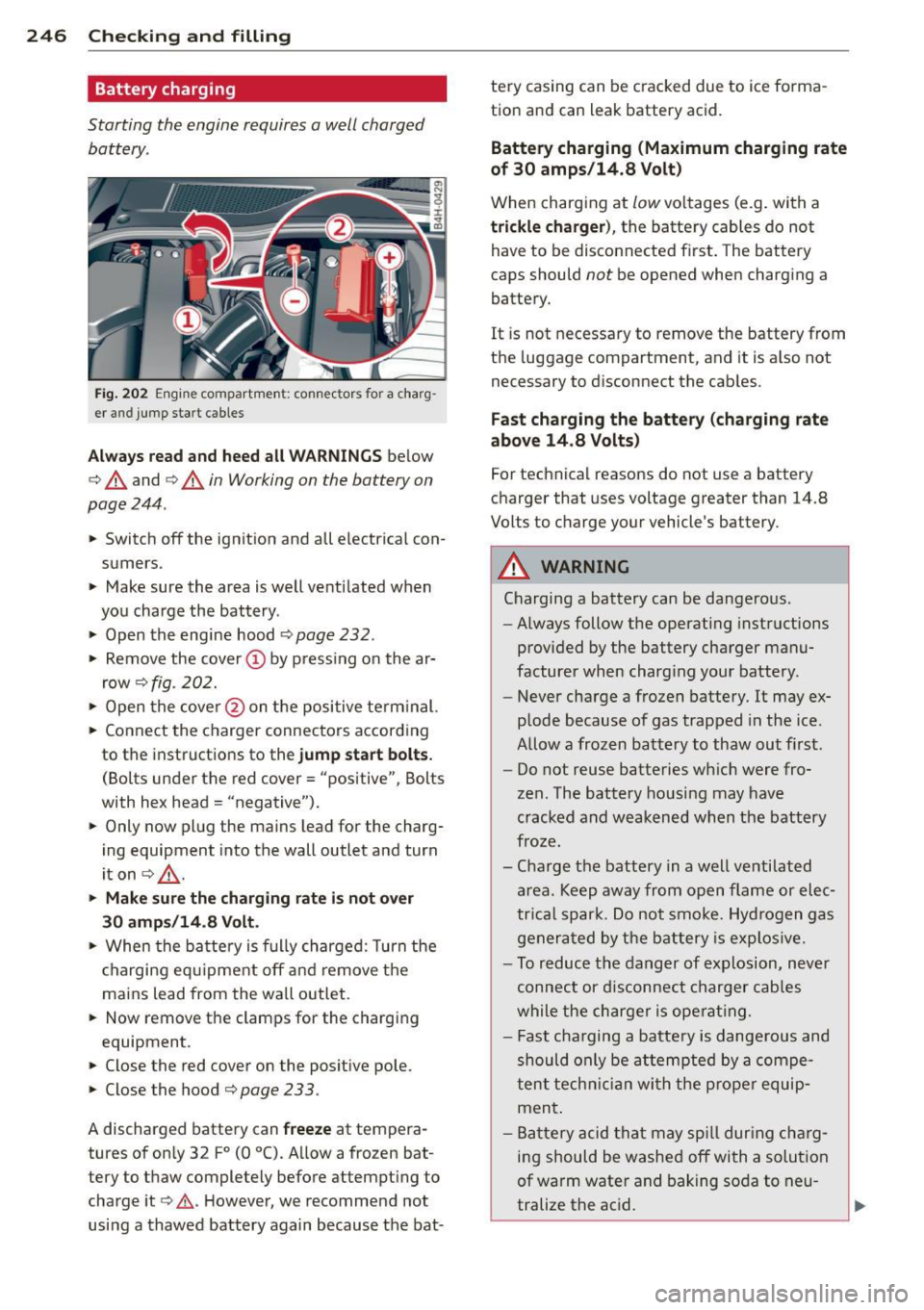
246 Checking and filling
Battery charging
Starting the engine requires a well charged
battery.
Fig . 202 Engine co mpartme nt: connectors fo r a charg
er and jump sta rt cables
Always read and heed all WARNINGS below
c:> A and c:> A in Working on the battery on
page 244 .
.,. Switch off the ignition and all electrical con
sumers .
.,. Make sure the area is well ventilated when
you charge the battery .
.,. Open the engine hood
r:::.> page 232 .
.,. Remove the cover© by press ing on the ar
row
c:>fig . 202.
.,. Open the cover @on the positive term inal.
.,. Connect the charger connectors according
to the instructions to the
jump start bolts.
(Bolts under the red cover= "positive" , Bolts
with hex head = "negative").
.,. Only now plug the mains lead for the charg
ing equipment into the wall outlet and turn
it on
r:::.> &_ .
.,. Make sure the charging rate i s not over
30 amps/14.8 Volt.
.,. When the battery is fully charged: Turn the
charging equipment off and remove the
mai ns lead from the wall outlet.
.,. Now
remove the clamps for the charging
equipment.
.. Close the red cover on the posit ive pole .
.,. Close the hood
c:> page 233 .
A discharged battery can freeze at tempera
tures of only 32 F
0 (0 °C). Allow a frozen bat
tery to thaw completely before attempting to
charge it
r:::.> &. . However , we recommend not
using a thawed battery again because the bat -tery casing can be cracked due to ice forma
tion and can leak battery acid.
Battery charging (Maximum charging rate
of 30 amps/14.8 Volt)
When charging at low voltages (e.g. with a
trickle charger), the battery cables do not
have to be disconnected f irst. The battery
caps should
not be opened when charging a
battery.
It i s not necessary to remove the battery from
the luggage compartment, and it is also not
necessary to disconnect the cables.
Fast charging the battery (charging rate
above 14 .8 Volts )
For technical reasons do not use a battery
charger that uses voltage greater than 14.8
Volts to charge your vehicle's battery .
A WARNING
Charging a battery can be dangerous.
- Always follow the operating instructions
provided by the battery charger manu
facturer when charg ing your battery .
- Never charge a frozen battery. It may ex
plode because of gas trapped in the ice .
Allow a frozen battery to thaw out first .
- Do not reuse batteries wh ich were fro
zen. The battery housing may have
cracked and weakened when the battery
froze.
- Charge the battery in a well ventilated area . Keep away from open flame or elec
tr ica l spar k. Do not smoke. Hydrogen gas
generated by the battery is explos ive .
- To reduce the danger of explosion,
never
connect or disconnect charger cables
while the charger is operating .
- Fast charging a battery is dangerous and
should only be attempted by a compe
tent technician with the proper equip
ment .
- Battery acid that may spill dur ing charg
ing should be washed off with a solution
of warm water and baking soda to neu
tralize the acid.
Page 307 of 318

starting .... ................ ... .... 83
Starting with jumper cables . ... .. .. . 284
Stopping . . . . . . . . . . . . . . . . . . . . . . . . . . 84
Engine compartment ....... .. .. .. .. . 234
C losing the hood ......... .. .. .. .. . 233
Opening the hood .............. .. . 232
Safety instructions ................. 232
Working in the engine compartment .. 232
Engine coolant . ........... .. .. .. ... 240
Adding coolant ........... .. .. .. .. . 241
Checking the engine coolant level .. .. . 240
Expansion tank .............. ... ... 240
Malfunction symbol .......... ... .. .. 16
Radiator fan ............. .... .. .. . 242
Temperature gauge ....... .. .. .. .. .. 10
Engine oil ... ................ ... ... 235
Adding .... ................ ... ... 238
Additives ... ................ ... ... 238
Changing .. ............. .... .. ... 239
Checking oil level ......... .. .. .. .. . 238
Checking the engine oil level .. .. .. .. . 237
Consumption ............... .... .. 238
Indications and conditions requiring ex-
tra checking ............. .... .. ... 23 7
I ndicator light . . . . . . . . . . . . . . . . . . . . . 17
O il consumption .......... .. .. .. .. . 236
Oil grades .. ................ ... ... 235
Oil level symbol ................ .... 20
Pressure malfunction ......... ..... .. 17
Recommended oil check intervals .. .. . 237
Sensor defective . . . . . . . . . . . . . . . . . . . . 21
Specification and viscosity .. .. .. .. .. . 235
Engine sound ................ ... ... 109
Engine speed limitation ....... .. .. .. .. 20
Engine start-stop mode
refer to Start-Stop-System . .. .. .. .. .. 89
Engine start system (indicator lights) . ... 17
Entry assistance . . . . . . . . . . . . . . . . . . . . . 63
Environment Break-in period ........... .. .. .. ... 206
Catalytic converter . ....... .. .. .. .. . 207
Disposing of your vehicle battery .... . 247
Driving at high speeds ...... ... ... .. 209
Driving to minimize pollution and noise 208
Fuel ... .. .. .. ............. .. .. ... 230
Fuel economy ............ .... .. .. . 208
Leaks under your vehicle ............ 232
Letting the vehicle stand and warm up. 209
Index 305
Proper disposal of drained brake fluid . 243
Proper disposal of drained engine cool-
ant ....... ... .. .. ............... 241
Proper disposal of drained engine
oil . . . . . . . . . . . . . . . . . . . . . . . . . 238, 239
Recycling used engine oil ............ 238
Unleaded fuel .. .. .. . .. .... ........ 228
What should I do with an old battery? . 247
EPC
refer to E lectronic power control (EPC) . 20
ESC
refer to Electronic Stabilization Control
(ESC) ............................ 198
ESC (Electronic Stab ilization Control)
Warning/ind icator lights ............ . 18
Event Data Recorder (EDR) ............ 198
Exhaust tail pipes .. .. .............. . 222
Expansion tank .. .. ................. 240
Exterior lighting . .. ................. . 45
Exterior mirrors Adjusting . . . . . . . . . . . . . . . . . . . . . . . . . 54
Dimming ... ... .... ................ 54
Heating ... .. .. .. .... ............. . 54
Exterior temperature display ........ .. . 23
F
Fastening
Booster seats .. .. .... ......... .... 184
Convertib le child safety seats .... .. .. 183
Infant seats . . . . . . . . . . . . . . . . . . . . . . 182
Floor mats . . . . . . . . . . . . . . . . . . . . . . . . . 140
Fo lding table .. .. .. .. ............... . 68
Foot pedals ... .. .... ... .......... .. 139
For the sake of the environment Gasoline fumes and the environment .. 230
Reducing engine noise by ear ly upshift-
ing ....... .. .. .. .. .. ........... .. . 10
Refueling . .. .. .. .. ............... 230
Saving fuel by early upshifting ....... . 10
Four zone automatic climate control ..... 79
Front airbags Description .. .. .. ................. 156
How they work . .. ................. 161
Frontal collisions and the laws of physics 145
Front passenger seat adjustment . . . . . . . 63
•
•
Page 308 of 318
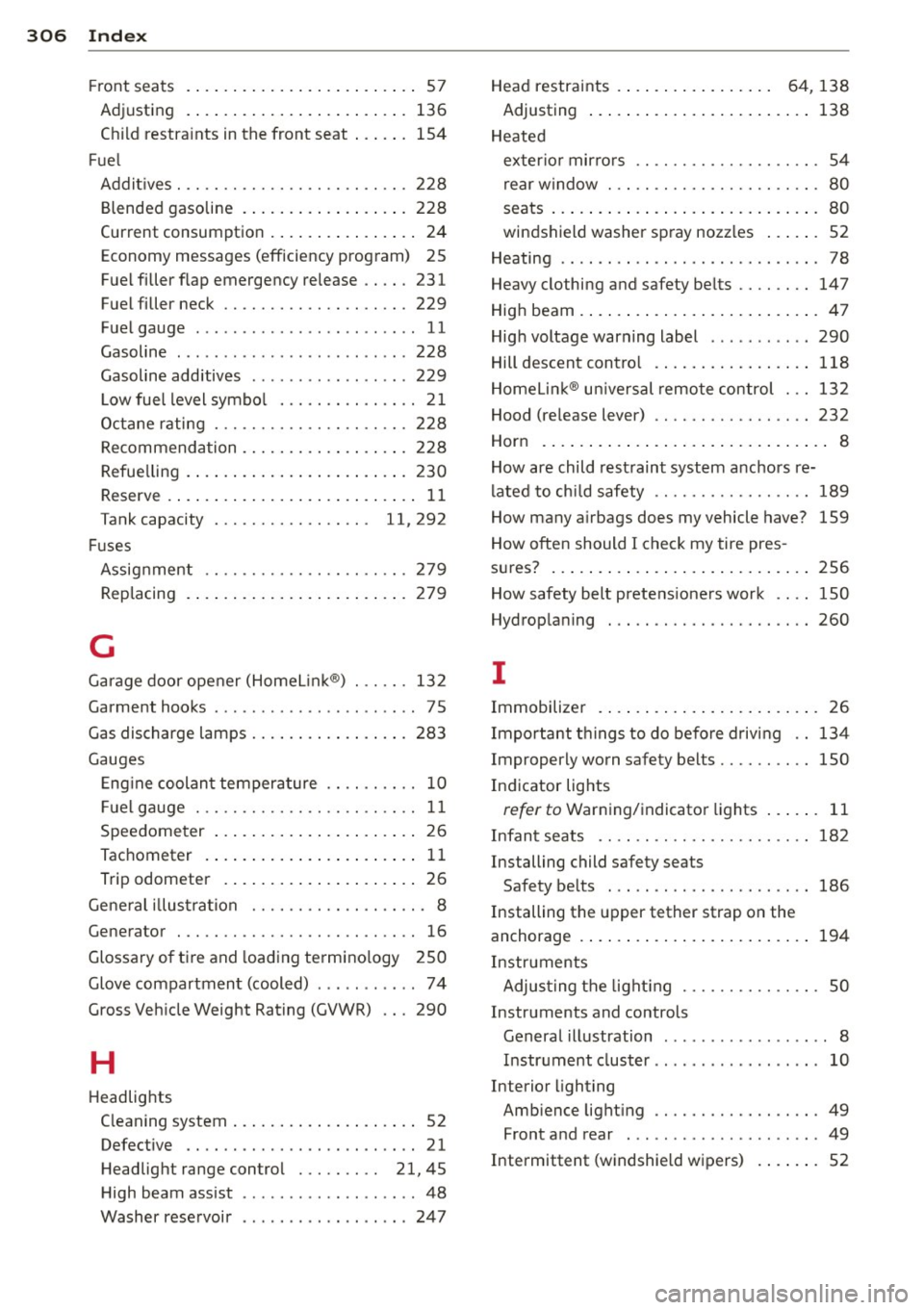
306 Index
Front seats . ............... ... .... .. 57
Adjusting . ................. ..... . 136
Child restraints in the front seat ... .. . 154
Fuel Addit ives . .... ........... .. .. .... . 228
Bl ended gasoline .......... ... .... . 228
Current consumption . . . . . . . . . . . . . . . . 24
Economy messages (efficiency program) 25
Fuel filler flap emergency relea se .. .. . 231
Fuel filler neck ............. .. .... . 229
Fuel gauge . . . . . . . . . . . . . . . . . . . . . . . . 11
Gasoline ... ... ... .... ......... .. . 228
Gasoline additives ............ .. ... 229
L ow fuel level symbo l . . . . . . . . . . . . . . . 21
Octane rating .......... .. .. .. .. .. . 228
Recommendation .......... ... .... . 228
Refue lling . ................. ..... . 230
Reserve .................... ..... .. 11
Tank capacity . . . . . . . . . . . . . . . . . 11,292
Fuses Assignment ...................... 279
Replacing .. ................ ..... . 279
G
Garage door opener (Homelink®) . .. .. . 132
Garment hooks .. ... .... ......... .. .. 75
Gas discharge lamps ......... ... .. .. . 283
Gauges Engine coolant temperature .. .. .. .... 10
Fuel gauge . . . . . . . . . . . . . . . . . . . . . . . . 11
Speedometer . . . . . . . . . . . . . . . . . . . . . . 26
Tachometer . . . . . . . . . . . . . . . . . . . . . . . 11
Trip odometer . . . . . . . . . . . . . . . . . . . . . 26
General illustration ............ .... ... 8
Generator . ................. .. .... .. 16
Glossary of tire and loading terminology 250
Glove compartment (cooled) ...... ..... 74
Gross Vehicle Weight Rating (GVWR) ... 290
H
Headlights
Cleaning system ............ .. .... .. 52
Defective . . . . . . . . . . . . . . . . . . . . . . . . . 21
He adlig ht range contro l . . . . . . . . . 21, 45
High beam assist .............. ... .. 48
Washer reservoir ............. .. ... 247 Head
restraints . . . . . . . . . . . . . . . . . 64, 138
Adjusting ..... .. ................. 138
H eated
exter ior mirrors . . . . . . . . . . . . . . . . . . . . 54
rear window ... .. ............. .... . 80
seats ......... .. .. .............. .. 80
windshield washer spray nozz les . . . . . . 52
H eating .. .. .. .. .. .. ............. .. . 78
Heavy clothing and safety belts ........ 147
High beam . ..... .. ............. ..... 47
High voltage warning label ..... .. .. .. 290
Hill descent contro l ................ . 118
Homelink ® un iversal remote control ... 132
Hood (release lever) ... .......... .. .. 232
Horn ..... ..... .. .. .............. ... 8
How are child restraint system anchors re-
lated to child safety ............. .. .. 189
How many air bags does my vehicle have? 159
How often should I check my tire pres-
sures? ......... .. .. .............. . 256
How safety belt pretens ioners work .. .. 150
Hydroplaning ... .. ............. .... 260
I
Immobilizer . . . . . . . . . . . . . . . . . . . . . . . . 26
Important things to do before driving .. 134
Improperly worn safety belts .......... 150
Indicator lights
refer to Warning/indicator lights ..... . 11
Infant seats .. .. .. ... .......... .... 182
Installing child safety seats Safety belts . . . . . . . . . . . . . . . . . . . . . . 186
Installing the upper tether strap on the
anchorage . ..... .. ................. 194
Instruments Adjusting the light ing .......... .... . 50
Instruments and controls
General illustration . . . . . . . . . . . . . . . . . . 8
Instrument cluster .................. 10
Interior lighting
Ambience lighting ............. .. .. . 49
Front and rear ... .. ..... ...... .. .. . 49
Intermittent (windshield wipers) ... ... . 52
Page 310 of 318
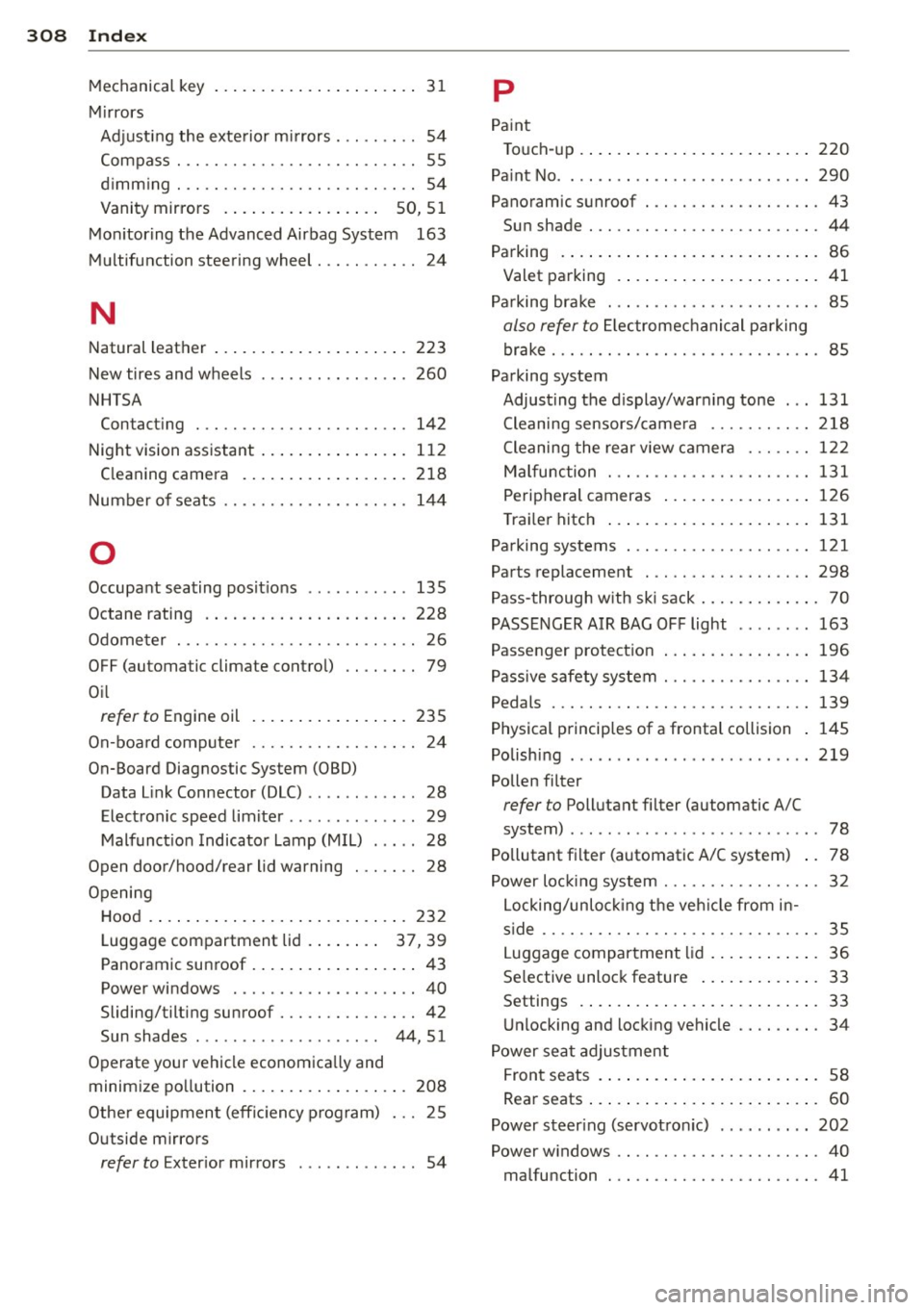
308 Index
Mechanical key . . . . . . . . . . . . . . . . . . . . . . 31
Mirrors Adjusting the exterior mirrors . .. .... .. 54
Compass ................ .. .. .. .. .. 55
dimming ................ .. .. .... .. 54
Vanity mirrors . . . . . . . . . . . . . . . . . SO,
s 1
Monitoring the Advanced Airbag System 163
Mult ifunction stee ring wheel ......... .. 24
N
Natural leather ................ .... .
New tires and wheels
NHTSA 223
260
Contacting ... ........... ........ . 142
N ight vision assistant ........ ... .... .
C leaning camera .......... ... .... .
Number of seats
......... .... .. .. .. .
0
112
218
144
Occupant seating pos it ions ....... .... 135
Octane rating ................ ... .. . 228
Odometer · · · · · · · · · · · · · · · · · ... .... .. 26
OFF (automatic climate control) . . . . . . . . 79
Oi l
refer to Engine oil
235
On-board computer .................. 24
On-Board Diagnostic System (OBD) Data Link Connector (DLC) .. .. .. .. .. . . 28
E lectronic speed limiter . . . . . . . . . . . . . . 29
Malfunction Indicator Lamp (MIL) . . . . . 28
Open door/hood/rear lid warning . . . . . . . 28
Opening Hood .... .. ................ ..... . 232
Luggag e compartment lid . . . . . . . . 37, 39
Panoramic sunroof ......... ... .... .. 43
Power windows .............. .... .. 40
Sliding/tilting sunro of ......... ...... 42
Sun shades . . . . . . . . . . . . . . . . . . . . 44, 51
Operate your vehicle economica lly and
minimize pollution .......... ... .... . 208
Othe r equipment (effic iency program ) 25
Outside mirrors
refer to Exterior mirrors . . . . . . . . . . . . . 54
p
Paint
Touch-up .. .... .. .. .............. .
Paint No .
..........................
220
290
Panoramic sunroof .... .......... ..... 43
Sun shade . ........................ 44
Parking ... ..... .. .. ............. _ .. 86
Valet parking .... .................. 41
Parking brake ..... ... .......... ..... 85
also refer to Electromechanical parking
brake · · · · · · · · · · · · · · · · · ............ 85
Parking system
Adjust ing the display/war ning tone ... 131
Cleaning sensors/camera ........... 218
Cleaning the rear view camera ....... 122
Malfunction ..... ............... .. 131
P eripheral cameras ............ ... _ 126
T ra iler hitch ..... ................. 131
Parking systems ................ .... 121
Parts replacement . ............. .... 298
Pass-through with ski sack ............ . 70
PASSENGER AIR BAG OFF light .. ..... . 163
Passenger protection . . . . . . . . . . . . . . . . 196
Passive safety system .............. .. 134
Pedals ..... ....................... 139
Physical principles of a frontal collision . 145
Polishing .......................... 219
Pollen filter
refer to Pollutant filter (automatic A/C
system) .. ... .. .. .. ..... ...... . _ ._ . 78
Pollutant filter (automatic A/C system) .. 78
Power locking system .............. ... 32
Locking/unlocking the vehicle from in-
s ide
· · · · · · ....................... . 35
Luggag e compartment lid . . . . . . . . . . . . 36
Se lective unlock feature . . . . . . . . . . . . . 33
Settings . ..... .. ........... _ .. .. _ . 33
Unlo cking and locking vehicle ......... 34
Power seat adjustment Front seats . . . . . . . . . . . . . . . . . . . . . . . . 58
Rear seats ..... .. .. ............. _ . . 60
Power steer ing (servotronic) .......... 202
Power windows ...................... 40
malfunction · · · · · · · · · · · ............ 41